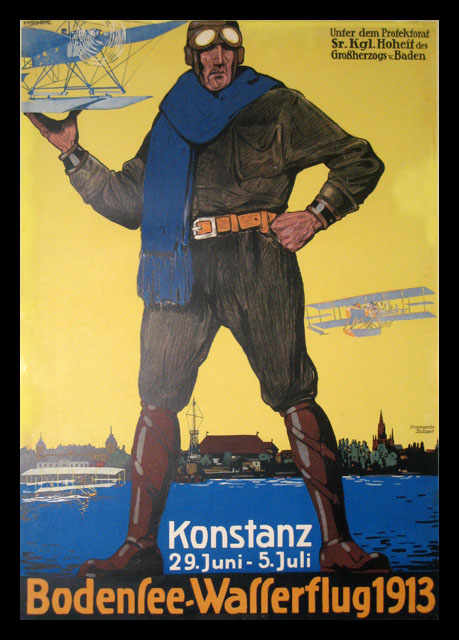 |
Title: Bodensee-Wasserflug
Artist: Heinrich H. Schütz
Year of Publication: 1913
Publisher: Propaganda Stuttgart
Language: German
Size:
Index Number: 00304
Description:
Week-long aviation exhibitions were popular events between the years 1909 and 1914. While most cities hosted pilots flying all sorts of aircraft, some featured hydro-airplanes—aircraft outfitted with floats to land and take off from a body of water. In the summer of 1913, the Grand Duke of Baden, also known as Frederick II, also known as King of Prussia sponsored such an event on the shore of Lake Constance (Der Bodensee) that abutted the German province of Baden-Württemberg. The city of Konstanz, home to German airship designer Count Ferdinand von Zeppelin, was well acquainted with aviation.
At the meet, the celebrated German pilot Hellmuth Hirth (1886—1938) took first place in his Albatros monoplane, with second place going to another German, Willy Truckenbrodt. |
|
Hirth worked for the American inventor Thomas Edison in the United States in his younger years, returning to Germany in 1909 to work on German airplanes. Not only was he a famous and accomplished pilot, but an engineer as well, developing successful engine designs. When he died in a plane crash in 1938, German aircraft manufacturing, Ernst Heinkel took over his company.
Artist Heinrich H. Schütz (1875—1956) created an image that evokes the Colossus of Rhodes from antiquity. This powerful character, presumably of a German aviator, stands across Lake Constance, sternly gazing out at the viewer, holding what appears to be Hirth’s Albatros monoplane in his outstretched hand. What appears to be a Curtiss Model F flying boat flies behind the figure to the right, while other biplanes float in the lower left-hand corner. The towering figure not only epitomizes German strength and victory at the meet, but his militaristic mien reflects the reason why the meet was held: so the German navy could test the most recent seaplane designs.
BIBLIOGRAPHY |
